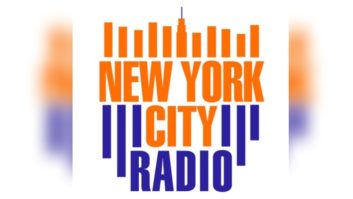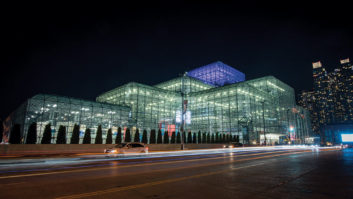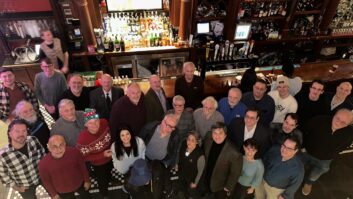From its inception, New York City radio station WOR(AM) has been a pioneering presence in broadcasting. Retailer Louis Bamberger started the heritage station in 1922 to support sales of crystal radios starting to appear on the shelves of his department stores. That Christmas, WOR was the only station broadcasting to the many who found gift-wrapped receivers under the tree.
Throughout the 20th century, WOR continued to pioneer technologically and creatively. The station introduced listeners to many of the best-known radio programs including “The Shadow,” “Nick Carter, Private Detective,” “Twenty Questions,” “True or False” and “Rambling with Gambling.” WOR was a frequent home to such notable personalities as Milton Berle, Vincent Price, Bob and Ray and John Gambling.
Dawn of the digital
In late 2002, the Buckley Broadcasting station became the first AM in the New York City area to broadcast in Ibiquity Digital’s HD Radio format. Proponents of the in-band, on-channel technology behind HD Radio believe it will breathe new life and fidelity into many AM stations poised to follow in WOR’s footsteps.
Tom Ray, Buckley Broadcasting/WOR corporate director of engineering, spearheaded WOR’s leap into the world of HD Radio. His station worked with Ibiquity throughout the conversion to the hybrid analog/digital broadcasting format and subsequent testing phase.
Depending on the state of a station’s existing equipment, bringing a transmitter site up to IBOC digital spec has the potential of significant technical and financial challenges. But Ray said the addition of HD Radio required few changes to WOR’s production operations.
“Adding the digital broadcast had a minimal impact on the production side. Really the only thing we need to look out for is compounding digital audio file compression.”
Because Ibiquity Digital’s IBOC digital exciter must compress the program material, already-compressed files such as source MP3s will be recompressed, resulting in an increase in audible artifacts.
“Depending on the nature of the original compressed source, results range from imperceptible to quite noticeable,” Ray said.
Some easy steps can be taken to minimize recompression, but this requires getting the message across to content providers.
“A majority of commercials we receive show up in MP3 format attached to an e — mail — of course, if you told me that 10 years ago, I would have said, ‘You’re nuts!’ So now we continually stress the importance of sending us the highest quality possible, high-bit-rate MP3s. We would prefer WAV files, but they are far too large for e-mailing.”
In certain situations, however, recompression is not so easily avoided.
“For instance, the StarGuide satellite receivers are completely MP3 – that’s it, that’s the only choice,” Ray said. WOR receives and rebroadcasts satellite feeds from several sources including ABC News and Westwood One.
The fact that the Broadway-based station’s satellite receivers are at the New Jersey transmitter site complicates the matter.
“We bring back 10 satellite channels in MP3 format from the transmitter site on the bidirectional T1 Intraplex audio codec,” he said. “Because we send the programming from the studio to the transmitter uncompressed, remaining T1 bandwidth dictates that the 10 incoming satellite channels be compressed at the Intraplex. We compress as little as possible at this stage, but it is another cycle nonetheless.”
Analog constant
Apart from the caution of recompressed files, Ray says his production studios have undergone no other changes related to the IBOC broadcasts. In fact, the station is still using the five Pacific Recorders System One analog broadcast consoles it purchased in 1978 (serial numbers one through five), though they are about to be retired.
Ray said now that the conversion to IBOC is complete, the station is focusing its attention on upgrading the production studios. But it is in the midst of finalizing details of the building lease and potential facility expansion plans; any major overhaul will have to wait. For now, the station will install analog Audioarts and Wheatstone consoles.
“Switching the production end over to digital is in certainly in the cards for WOR, but it makes no sense to do it halfway in the interim.”
The station’s three on — air production studios and several off — line suites feature a range of pro audio and broadcast gear popular in the industry.
“External input sources include Denon CD and MD players, TASCAM and Denon cassette decks, Sony and Denon DAT machines, Comrex Vector POTS codec, Telos Zephyr ISDN codecs and the StarGuide satellite feeds,” Ray said.
“We use Electro — Voice RE — 20 and RE-27 microphones for the most part.”
For audio compression, Ray employs Symetrix 528E voice processors. “We generally use very little compression, just enough to keep people from slamming the meters home,” he explains.
For on-air playback and recording, WOR utilizes an ENCO DADpro MP-2 Digital Audio Delivery system with Digigram digital interface cards.
“On — air programming is fed from the board into the pre — processor, an Orban Optimod 8200-ST, for protection of the STL links out to the transmitter,” Ray said.
“At that point, programming goes out to the transmitter site over our T1 Intraplex link, which provides a non — compressed 15kHz — bandwith digital signal.”
The station also has a Moseley DSP 6000 and Moseley analog mono microwave links for backup systems. A dedicated analog landline between the studio and the transmitter site and a transmitter-site Comrex DXR ISDN codec provide additional STL backup options.
“And we have two hours of ‘The Best of WOR’ on DAT in case we have to abandon ship on Broadway,” Ray adds.
Up and coming
Of the 19 stations that Buckley owns, WOR is the only one broadcasting in digital.
“The other studio facilities and most of our transmitter sites are all set to plug it in. When radios start appearing on shelves, the other markets will most certainly come online.”
Right now those shelves are pretty bare; virtually no one can listen to the digital broadcasts as Ibiquity and pioneer stations navigate through the IBOC rollout phase. Ray anticipates the first consumer digital receivers to show up around Christmas. By next summer, he speculates, a decent variety of models should be available in stores and as installed options in new car purchases.
WOR is able to monitor digital broadcasts from the road through an Ibiquity test radio, which he jokingly describes as “half the size of a bus.” A second receiver resides in the station’s master control.
The New York metro area is a great place to put HD Radio through its paces, he said.
“In Manhattan and onto the New Jersey Turnpike, there are plenty of power lines to go under and bridges to cross. With the analog signal you get buzzes, whistles, fades and everything else. There’s virtually no interference on the digital signal.”
IBOC also is significantly more power-efficient than its analog counterpart.
“For example, our broadcast range extends about 95 miles towards Philadelphia before it falls apart. What’s incredible is when you consider that it takes a full 50,000 watts to get the analog signal that far, while the digital signal only uses 1,500.
“In typical AM, we can transmit up to 10 kHz, but your typical AM radio doesn’t hear much above three and a half, so the current limiting factor is the end-user’s radio. IBOC over AM goes almost to 15 kHz, a dramatic difference.”
Ray said listeners tuning in to the digital signal will pick up on the changes that enhance the listening experience.
“When the radio locks on to the WOR digital signal and switches from the analog, the sound just opens up and becomes much cleaner, for lack of a better term. And when we get a music bed or a commercial with music — we run a lot of spots for Broadway shows — it’s like night and day between the analog and digital.”
Speaking of night and day, FCC requirements limit all AM digital broadcasts to daytime hours. “Hopefully that will get worked out in the next couple of months,” Ray said.
WOR has been a technological pioneer in radio throughout its storied history. “We were doing facsimile broadcasts of printed media back in the ’50s, we were one of the first stations to incorporate a profanity delay, one of the first 50,000-watt stations in the country, one of the first to use a directional AM antenna,” Ray said. “So its just fitting that WOR is on the ground floor in the deployment and testing of IBOC.”











